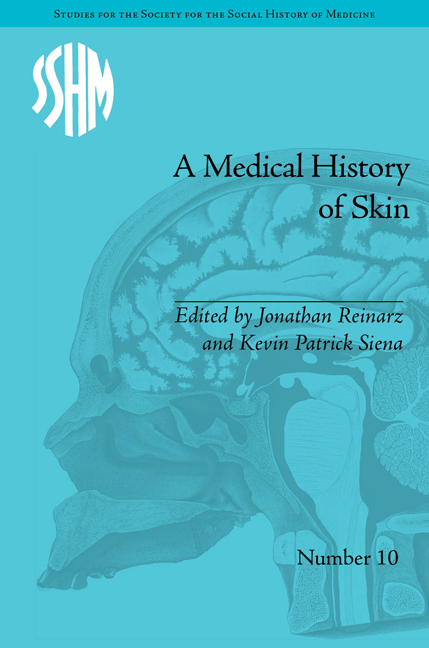Book contents
- Frontmatter
- CONTENTS
- List of Contributors
- List of Figures and Tables
- Scratching the Surface: An Introduction
- Part I The Emerging Skin Field
- Part II Skin, Stigma and Identity
- Part III Skin, Disease and Visual Culture
- 9 ‘An Alteration in the Human Countenance’: Inoculation, Vaccination and the Face of Smallpox in the Age of Jenner
- 10 Portraying Skin Disease: Robert Carswell's Dermatological Watercolours
- 11 Atavistic Marks and Risky Practices: The Tattoo in Medico-Legal Debate, 1850–1950
- 12 ‘Kissed by the Sun’: Tanning the Skin of the Sick with Light Therapeutics, c. 1890–1930
- 13 ‘Classic, Characteristic or Typical’: The Skin and the Visual Properties of External Anthrax Lesions
- Afterword: Reading the Skin, Discerning the Landscape: A Geo-historical Perspective of our Human Surface
- Notes
- Index
12 - ‘Kissed by the Sun’: Tanning the Skin of the Sick with Light Therapeutics, c. 1890–1930
from Part III - Skin, Disease and Visual Culture
- Frontmatter
- CONTENTS
- List of Contributors
- List of Figures and Tables
- Scratching the Surface: An Introduction
- Part I The Emerging Skin Field
- Part II Skin, Stigma and Identity
- Part III Skin, Disease and Visual Culture
- 9 ‘An Alteration in the Human Countenance’: Inoculation, Vaccination and the Face of Smallpox in the Age of Jenner
- 10 Portraying Skin Disease: Robert Carswell's Dermatological Watercolours
- 11 Atavistic Marks and Risky Practices: The Tattoo in Medico-Legal Debate, 1850–1950
- 12 ‘Kissed by the Sun’: Tanning the Skin of the Sick with Light Therapeutics, c. 1890–1930
- 13 ‘Classic, Characteristic or Typical’: The Skin and the Visual Properties of External Anthrax Lesions
- Afterword: Reading the Skin, Discerning the Landscape: A Geo-historical Perspective of our Human Surface
- Notes
- Index
Summary
Introduction
Among civilized people, the skin is universally anemic [sic] and enfeebled by the universal practice of over-clothing. In view of the important functions of the skin, there should be a widespread campaign to introduce sun-bathing and the construction of sunny open-air gymnasiums. The tanned skin is able to defend itself against cold and to protect the body against disease much more efficiently than the pale, anemic [sic] skin which has not been ‘kissed by the sun’.
To tan skin is to brown it, dye it, transform its properties. Whether one refers to the process of turning raw hide to treated leather (the verb's etymological origins), or that of pigmenting human skin from pallid whiteness to a bronzed, luxurious surface, the concept of tanning remains the same. In contributing to this edited volume on skin and its medical histories, this chapter focuses on an under-explored topic in early twentieth-century medicine: bodily exposure of tubercular patients to light, or, perhaps better put, a therapeutics of tanning. From the early 1890s onwards, physicians internationally became increasingly fascinated by the natural healing powers of light. The primary, though not sole, target of both heliotherapy (natural sun therapy) and phototherapy (artificial light therapy) was to treat tuberculosis in its various manifestations. This included pulmonary tuberculosis, Pott's disease, scrofula, bone and joint (‘surgical’) tuberculosis, and lupus vulgaris (tuberculosis of the skin). Heliotherapists and phototherapists sought to rid the body of tubercle bacilli, heal the disfiguring and suppurating wounds caused by them, and prevent further recurrences by building up the patient's physiological defences.
- Type
- Chapter
- Information
- A Medical History of SkinScratching the Surface, pp. 181 - 194Publisher: Pickering & ChattoFirst published in: 2014

